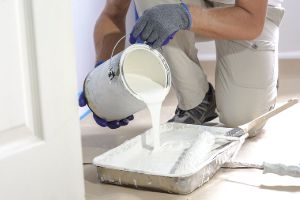
Although we often think of the word “organic” in a positive light, many Volatile Organic Compounds, or VOCs, are harmful to our health. How can you keep these chemicals from causing problems like headaches, nausea, shortness of breath, skin conditions, and even cancers? Knowing how long VOCs last can help you reduce your exposure at home and at work.
What Are VOCs? Where Do They Come From?
Volatile Organic Compounds, or VOCs, are gases that emit from certain solids and liquids. They are commonly found in many cleaning, building, household, and office products.
- Benzene / Dichlorobenzene
- Formaldehyde
- Ethanol
- Methylene Chloride
- Ethylene Glycol
- Terpenes
- Tetrachloroethylene
VOCs Can Stick Around Longer Than You Think
There’s no simple answer as to how long these substances take to dissipate. Opening windows and airing out your home can help clear the smell of cleaning materials relatively quickly.
Compounds in freshly applied paint might take five or six months to dissipate after application. Solid materials like particleboard can continue to off-gas for 20 years or even longer.
Sources Of Indoor Air Pollution
Virtually any human-made substance is a potential source of airborne pollutants. Even natural substances like hard and softwood from trees can emit volatile organic compounds.
- Carpets
- Paint
- Paint Strippers & Solvents
- Particle Board
- Cleaners & Disinfectants
- Air Fresheners
- Building Materials
Is Your Carpet A Culprit?
To help eliminate the new carpet smell, you can sprinkle with baking soda before vacuuming or use vinegar when steam cleaning. Be careful, though, when shampooing, as many carpet cleaning products themselves contain volatile chemicals.
And even with frequent cleaning, synthetic carpeting has dozens of chemicals that can emit for five years or even longer.
That New Paint Headache
Paint, stains, strippers, and solvents are notorious for having powerful smells that often lead to headaches and dizziness during initial exposure. If you ventilate well, the worst of the smell may wear off in a few days, but harmful gasses can continue to emit for six months or longer.
Fortunately, new, less-toxic varieties of paints, stains, and solvents have been introduced in recent years.
Is Your Mattress Or Furniture Making You Sick?
Polyurethane and memory foam are primary culprits, as are the plastics and flame retardants contained in your mattress, chairs, and sofas. Some of the toxic chemicals contained in furniture include formaldehyde, isocyanates, naphthalene, and benzene.
The worst of the smell will off-gas in less than a week, but less noticeable residual VOCs can continue to emit for years.
Cleaners, Disinfectants & Air Fresheners
From your favorite toilet cleaner and furniture polish to traditional cleaners like bleach and ammonia, all of these items can potentially emit VOCs. Artificially scented “air fresheners” are among the worst culprits, causing allergic reactions and breathing problems in sensitive individuals.
Do yourself, your family, and your staff a favor and choose natural cleaners while skipping the air fresheners altogether.
Reducing VOCs From Building Materials
From flooring materials and adhesives to drywall, plywood, fiberboard, and more, all kinds of materials used in your home and building construction are a potential source of VOCs. Unless you are building from the floor up, you might not be able to control what materials are used, but you can take steps to mitigate the emissions.
- If your home or office is already filled with particleboard and MDF furniture, consider using a sealer to minimize off-gassing.
- Use HEPA filters in your vacuum and your ventilation system.
- Air purifiers, NOT chemical air fresheners, can significantly improve interior air quality.
- Consider replacing your carpeting with a natural flooring product.
- When replacing mattresses and furniture, seek out a brand that does not use polyurethane foam and that includes primarily organic content, such as wool, cotton, or natural latex.
- Open your windows if the outside air quality is good. Increasing ventilation can help improve indoor air quality, so long as the air coming in is not itself tainted with smoke, smog, or fumes from nearby traffic.
Air Quality Testing In Monterey County
If you’re worried about VOCs or other contaminants in your home or workplace, call M3 Environmental. We offer indoor air quality testing to help pinpoint problems so that you can take steps to mitigate them.
Don’t let bad air make you, your family, or your employees sick. Contact us today for more information or to set up an appointment.





